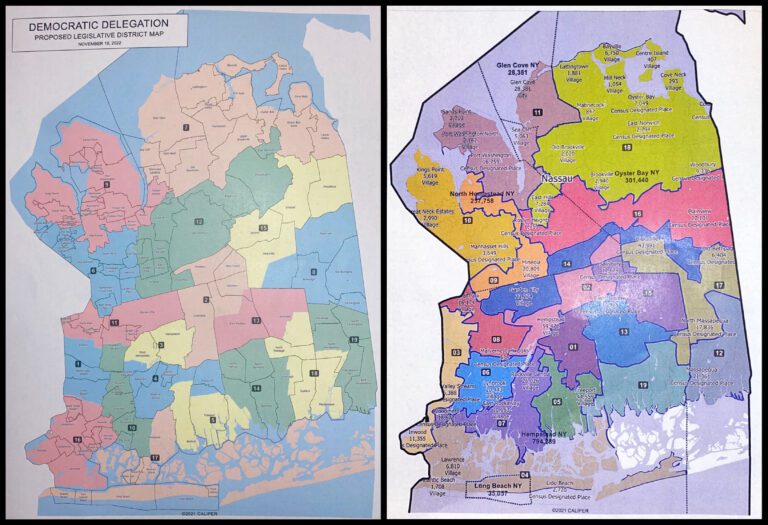
Nassau County’s Temporary Districting Advisory Commission work session devolved into an ideological standoff over legality, with no clear path ahead of their Nov. 21 deadline to vote on a single map to send to county legislators.
Every decade, the county redraws the boundaries of its legislative districts so that none have a significantly disproportionate difference in voter population when compared to other districts. The map was last withdrawn in 2013.
Democratic officials have chastised Republicans for a lack of transparency throughout the formation of the 2023 map. They have contended the Republican proposal allows officials to choose their representatives rather than the public.
“Our proposal eliminates partisan gerrymandering, complies fully with state and federal laws and enhances equity by ensuring there are five minority-majority districts where Black and Latino residents have the ability to elect the candidates of their choice,” said Democratic Committee Chair Dave Mejias said.
Officials intended for the work session to be a place for discussion and analysis of both proposed maps. But differences between the two parties scuttled that plan.
Megan Gall, the founder of Blockwell Consulting and the creator of the Democratic map, gave her presentation without sparking any conflict. However, the Republican map’s creator, Skyline Consulting Vice President David Schaefer, saw Democrats’ disagreements with his map extend the Thursday meeting past its two-hour limit and raise the prospect of future legal action.
“The people paying a million dollars deserve to know whether or not we’re truly doing this in a nonpartisan manner,” Mejias said. “Because that’s what the law tells us we have to do. So, in following the law, I want to know if there’s a particular bias.”
Republicans based their new map on the one they used in 2013. Democrats claim it continues gerrymandering and discriminates against minorities — Republicans denied these claims. (Schaefer also created the map in 2013.)
The Republican map features more misshapen borders, with many communities divided into separate districts. It divides communities like the Village of Hempstead into two districts, while the Democratic proposal makes it one.
Their plan would also divide East Meadow, Freeport, Hicksville and the Five Towns into four, four, four and three districts, respectively. Democrats would divide those particular areas into one, two, two and two districts.
The Greater Roslyn area in North Hempstead, which is and would be four districts under the Republican map, is three in the Democrats’ proposal.
Schaefer said his map is legal but the commission may find it flawed. He noted his goal in creating his first draft is to abide by the law.
The commission’s goal is to create a fair map of Nassau County based on comparable populations, demographics and legal standards. Both Republican and Democratic delegates presented their maps to the public for the first time during the meeting. Each party also questioned the other’s mapmaker about their creative process.
Democrats pressed Schaefer on several issues, which they alleged he was not adequately responding to. In particular, they questioned him about his lack of districts with a majority of minority residents, the division of specific areas and his decision to ignore public testimony.
“It is clear to me after hearing what Mr. Schaefer said that none of that was considered in drawing this map,” commission member Michael Pernick said. “Instead, you’ve based this current map on the map drawn in 2013. That map, as we pointed out, [that] we’ve had our experts do analysis, is illegal. You are jeopardizing the county with a potential lawsuit for not taking that under consideration and it’s scary to me.”
Schaefer said he expects to change the map based on public testimony and that he will change whatever he is told to. When asked about the details of certain districts, he reiterated he followed the law and maintained an equal population.
“My practice in my business is to produce a first draft map that is going to be flawed because I don’t use public testimony or subjective information,” he said.” I just got to a plan that would comply with all the laws.”
When asked if he knew the vote was Nov. 21, Schaefer said he was “aware that it was in November.”
Republican committee members claimed questions posed by their Democratic colleagues were inappropriate. Committee Chairman Francis Moroney said Democrats were not questioning Schaefer in the same tone that the Republicans were questioning Gall.
“You’re way over the line and you know it,” he said. “You just don’t care because you want to sue us so bad that you’ll say anything to do it. And that’s what’s going on here. Leave the man alone.”
Legal action over redistricting would not be unprecedented in Nassau County. In North Hempstead, Mineola Mayor Paul Pereira, along with Town Republicans David Adhami and Dennis Walsh, recently filed a federal complaint against the Town in October, claiming that the newly confirmed redistricting maps are unconstitutional.
Both delegations agreed both maps had shortcomings and that they would meet again after making changes.
There will be a public comment session on Nov. 16. The committee will vote on the maps on Nov. 21.
Democrats have a better than 2-to-1 voter registration advantage over Republicans statewide, and they have won recent governorship elections by an average of 14%.
In Nassau, registered Democrats currently outnumber registered Republicans 422,000 to 322,000, with 277,000 blanks (no party affiliation).
An influx of minority populations reflects Nassau County’s growing diversity, as detailed in the 2020 U.S. Census. Over the last decade, the county’s total population increased by over 56,000, or 4.2%. It is less than 5,000 people short of reaching 1.4 million, according to the data.






